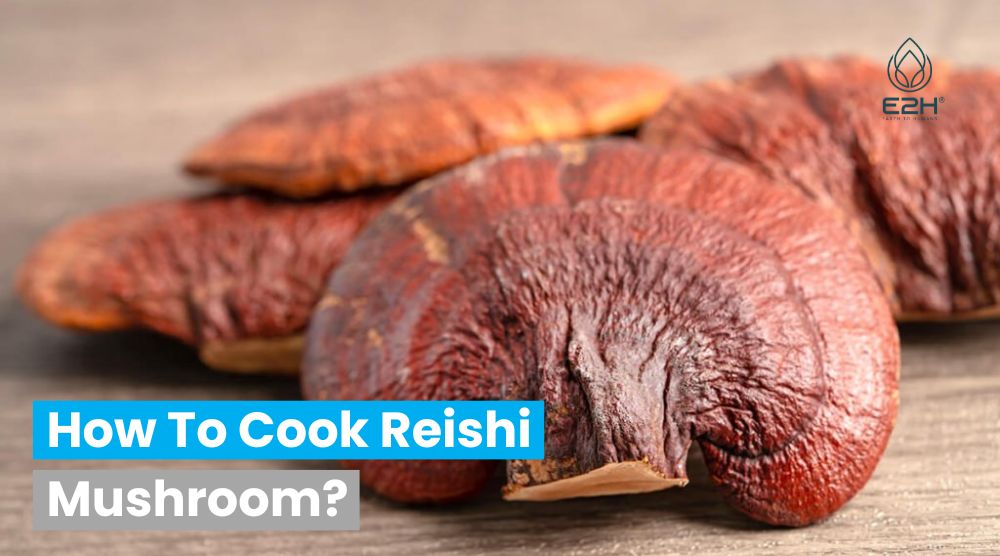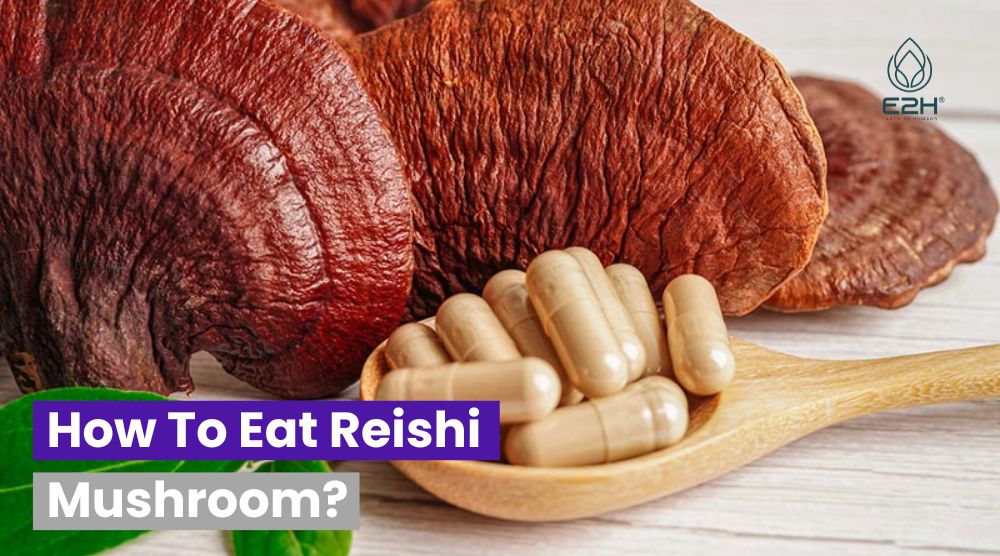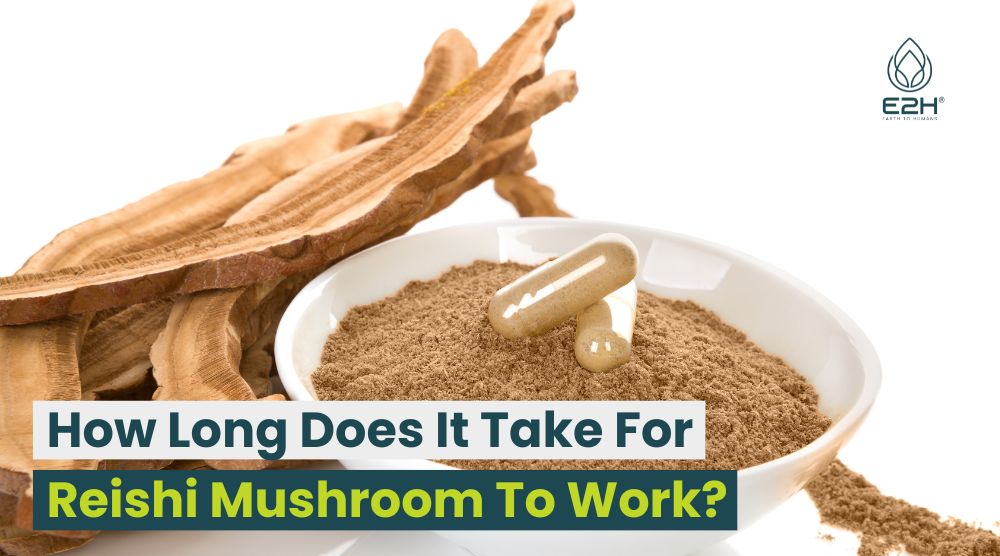I had a problem with finding a natural way to boost my health, and then I learned how to cook Reishi mushrooms! At first, their bitterness was a challenge, but I found out that simmering them in soups and making tea really worked.
I also learned that adding a bit of honey or ginger made them taste so much better. Now, I feel like I’ve got a secret weapon in my kitchen for staying healthy. My top tip? Cook Reishi mushrooms slowly to bring out their best!
How To Cook Reishi Mushroom: Best Ways
Cooking Reishi mushrooms can be a unique culinary experience due to their woody texture and bitter taste. Here are some of the best ways to cook Reishi mushrooms to enjoy their health benefits and flavor:
Reishi Tea or Broth:
One of the most common methods to consume Reishi mushrooms is by making a tea or broth. This involves simmering dried Reishi slices in water for at least an hour. The slow simmer allows the water-soluble medicinal mushroom compounds, like beta-glucans, to infuse into the liquid. You can add ginger, honey, or maple syrup to balance the bitterness.
Reishi Tincture:
For those looking for a more potent and convenient way to consume Reishi, a tincture might be the answer. This involves soaking dried Reishi in alcohol for several weeks to extract the beneficial compounds, which are alcohol soluble. The resulting tincture can be used in small amounts to add to drinks or food.

Soups and Stews:
Adding powdered Reishi mushroom or finely chopped pieces to soups and stews can enhance their medicinal value. Reishi’s earthy flavor complements natural flavors in savory dishes. It’s best to add Reishi at the beginning of the cooking process to allow its tough texture to soften and its beneficial compounds to meld with the dish.
Stir-Fry:
Incorporate finely sliced fresh Reishi mushrooms into a stir-fry. The high heat and quick cooking method can help to break down the dried mushrooms” fibrous texture. Pair it with soy sauce, garlic, and other savory ingredients to offset the bitterness.
Medicinal Extracts:
For those who find the taste of Reishi too strong, medicinal extracts in powder form can be a great alternative. The powder can be mixed into smoothies, almond milk, or baked goods, allowing you to enjoy the health benefits without the bitter taste.
How do you prepare fresh Reishi mushrooms for cooking?
Preparing fresh Reishi mushrooms for cooking involves a few steps due to their tough texture:
- Clean the Mushrooms: Gently brush off any dirt or debris from the Reishi mushrooms. Avoid rinsing them as they can absorb water and become too soggy.
- Slice the Mushrooms: Using a sharp knife, cut the Reishi mushrooms into thin slices. The cap and the stem can both be used, but if the stem is too reddish cap is too woody, it might be best to use only the cap.
- Boil to Soften: Place the sliced Reishi mushrooms in a pot of water and bring it to a boil. Reduce the heat and simmer for at least 2 hours. This process helps to soften the mushrooms and release their active compounds.
- Strain and Reserve the Liquid: After simmering, strain the mushrooms, but keep the liquid. This broth contains many of the mushrooms’ beneficial properties and can be used in recipes.
- Final Preparation: The softened Reishi slices can now be used in various recipes, such as soups, teas, or broths. They can also be dried out in a dehydrator to be ground into powder for later use.
What are the best methods for cooking Reishi mushrooms?
The best methods for cooking Reishi mushrooms involve simmering them to make a tea or broth, as their woody texture softens with prolonged heating. Dried Reishi can be steeped for several hours to extract their medicinal properties.
For culinary uses, finely chopped Reishi can be added to soups, stews, or stir-fries, paired with strong flavors to counteract their inherent bitterness. Reishi powder is also versatile, suitable for blending into smoothies or for use in making healthful tonics.
Can Reishi mushrooms be eaten raw or do they need to be cooked?
Reishi mushrooms are not typically consumed raw due to their tough and woody texture, as well as their bitter taste. They are usually dried and then cooked or steeped in hot water to make tea or broth. Cooking not only softens them but also helps to release their beneficial compounds, making them easier to digest and allowing the body to absorb their medicinal properties more effectively. Always cook Reishi mushrooms before consumption to ensure they are palatable and safe to eat.
5 simple Reishi mushroom recipes for beginners
Here are five simple Reishi mushroom recipes perfect for beginners:
1. Reishi Mushroom Tea:
- Simmer 5 grams of dried Reishi mushroom slices in 4 cups of water for 2 hours.
- Strain and serve with honey or lemon to taste.
2. Reishi and Vegetable Soup:
- Sauté your choice of vegetables (carrots, onions, celery) in a pot.
- Add 6 cups of vegetable broth and 1 tablespoon of Reishi powder.
- Simmer for 30 minutes, season with salt and pepper, and serve.
3. Reishi Mushroom Smoothie:
- Blend 1 banana, 1 cup of almond milk, 1 teaspoon of Reishi powder, and a handful of spinach until smooth.
- Sweeten with honey or maple syrup if desired.
4. Reishi Chocolate Truffles:
- Melt 1 cup of dark chocolate and mix in 1 teaspoon of Reishi powder.
- Form into balls and coat with cocoa powder, then chill until set.
5. Reishi Oatmeal:
- Cook oatmeal as per usual and stir in ½ teaspoon of Reishi powder.
- Top with fruits, nuts, and a drizzle of honey.
What spices and herbs pair well with Reishi mushrooms?
Reishi mushrooms have a distinct earthy and slightly bitter taste, which can be complemented by a variety of spices and herbs. When preparing dishes with Reishi, consider using:
- Ginger: Its sharp, pungent flavor pairs well with the earthiness of Reishi, adding a warming note to teas and broths.
- Garlic: With its robust flavor, garlic can stand up to Reishi’s bitterness and is excellent in stir-fries or medicinal broths.
- Turmeric: Known for its anti-inflammatory properties, turmeric adds a bright, peppery taste that works well with Reishi, especially in soups.
- Cinnamon: For a sweet and warming contrast, cinnamon can be added to Reishi teas or even baked goods.
- Star Anise: This spice offers a licorice-like sweetness that can soften the bitter edges of Reishi in slow-cooked dishes.
- Thyme: Its subtle, dry aroma and slightly minty flavor make thyme a good herb for Reishi-infused oils or savory recipes.
- Rosemary: With its piney fragrance, rosemary can add depth to Reishi dishes, particularly in roasted preparations.
- Basil: The sweet and fresh flavor of basil can lighten the intensity of Reishi, suitable for pestos or sauces.
Can Reishi mushrooms be used in soups and stews?
Yes, Reishi mushrooms can be used in soups and stews. Their robust texture holds up well during the long cooking process, allowing the flavors to meld. When preparing soups and stews, Reishi mushrooms are typically added in dried form. They’re often simmered for a couple of hours to soften them up and extract their flavors and beneficial compounds into the broth.
This slow simmering process also helps to mitigate their naturally bitter taste, making them more palatable. Reishi mushrooms contribute a deep, earthy flavor to dishes and can be paired with other mushrooms, root vegetables, and herbs for a hearty and healthful meal.
What are the health benefits of consuming cooked Reishi mushrooms?
Consuming cooked Reishi mushrooms offers several health benefits. They are known for their immune system support due to the presence of beta-glucans, which are known to help stimulate the immune response. Reishi mushrooms also contain compounds that may have anti-inflammatory and anti-aging properties.
Additionally, they have been used in traditional Chinese medicine to support restful sleep and lower blood pressure. While the exact mechanisms are still under study, the consumption of Reishi mushrooms is often linked to overall wellness and longevity, earning them the title “mushroom of immortality” in some cultures.
It’s important to note that while Reishi mushrooms are celebrated for their medicinal properties, they should be consumed as part of a balanced diet.
What is the taste of Reishi mushrooms and how can it be enhanced in cooking?
Reishi mushrooms have a distinctive woody texture and a bitter taste, which is quite different from the more commonly eaten varieties like button or portobello mushrooms. To enhance their flavor in cooking, it’s best to pair consuming Reishi mushrooms with strong, aromatic ingredients that can complement or mask their bitterness.
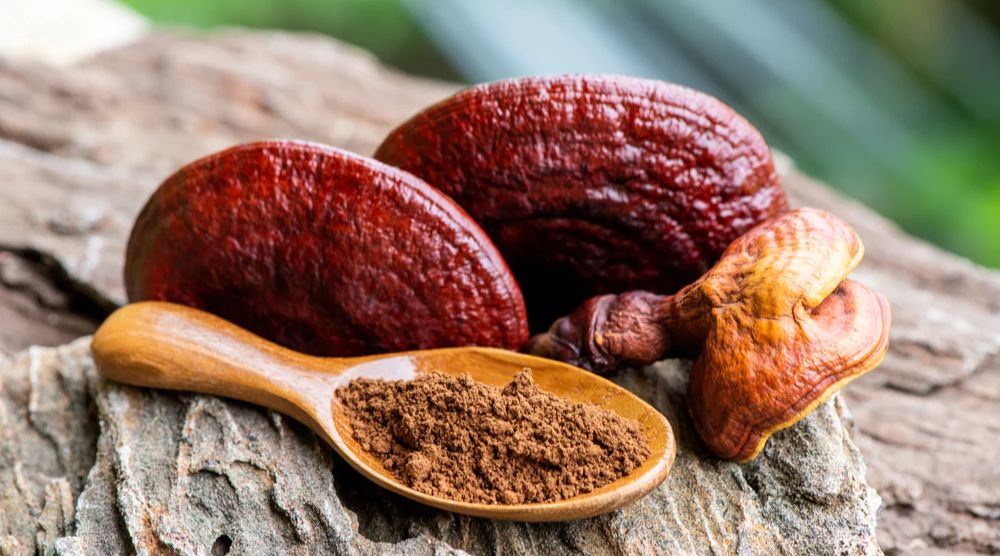
Ingredients like garlic, ginger, soy sauce, and star anise work well. Reishi mushrooms are often simmered in soups and broths, which allows their taste to mellow out and blend with other flavors. Adding a sweet element like carrots or onions can also help balance the bitterness.
Are there any vegan or vegetarian recipes that use Reishi mushrooms?
There are many vegan or vegetarian recipes that incorporate Reishi mushrooms, taking advantage of their medicinal properties. Reishi can be ground into a powder and added to vegan soups, stews, or broths. They can also be steeped to make a tea or used to create a rich, flavorful base for vegan gravy.
Another popular way to use or find Reishi mushrooms in vegan cooking is to blend the powder into smoothies or mix it into a batter for vegan pancakes or muffins, allowing the earthy flavor to add depth without overwhelming the dish.
Can Reishi mushrooms be used in making broths or stocks?
Yes, Reishi mushrooms are excellent for making broths or stocks. Their rich, earthy flavor and health-promoting properties make them a valuable addition to any broth. To use Reishi mushrooms in broths, add dried slices to your pot along with other vegetables and herbs.
Simmer for several hours to allow the flavors to infuse and the medicinal compounds to be released. The resulting broth can be used as a base for soups, sauces, or simply enjoyed on its own for its reputed medicinal benefits both to the immune system and overall wellness.
Some creative ways to incorporate Reishi mushrooms into everyday meals
Here are some delicious recipes and some creative ways to incorporate Reishi mushrooms into everyday meals:
- Reishi Tea Latte: Start your day with a warm Reishi mushroom tea latte by steeping Reishi tea and blending it with frothed milk and a touch of honey.
- Reishi Mushroom Oatmeal: Stir Reishi powder into your morning oatmeal along with cinnamon and fruit for an earthy twist.
- Reishi Smoothie Booster: Add Reishi powder to your favorite smoothie recipe for an extra health kick.
- Reishi Seasoning Blend: Mix Reishi powder with sea salt and other spices to create a unique seasoning for meats, tofu, or roasted vegetables.
- Reishi Soup Base: Use Reishi broth as the base for soups and stews, adding depth and medicinal properties to your comfort foods.
- Reishi Rice Cooker Hack: Add a few slices of Reishi mushroom to the rice cooker to infuse the rice with its nutrients.
- Reishi Herbal Tonic: Create a daily tonic with Reishi extract, lemon juice, and warm water to support your immune system.
- Reishi Pasta Sauce: Blend Reishi powder into tomato sauces or pesto for a nutrient-dense pasta topping.
- Reishi Baking: Incorporate Reishi powder into bread, muffins, or pancake batter for a healthful twist on baked goods.
- Reishi Chocolate Treats: Melt dark chocolate and mix in Reishi powder for homemade chocolate bars or truffles with a healthful edge.
How do you store Reishi mushrooms after cooking?
After cooking Reishi mushrooms, they should be stored properly to maintain their benefits and flavor. If you have made a broth or tea, it can be stored in the refrigerator for up to 1 week in an airtight container.
For solid cooked dried Reishi mushrooms, let them cool completely before placing them in a sealed container; they can be refrigerated for up to five days. For longer storage, cooked Reishi mushrooms can be frozen. Freeze them in a single layer on a baking sheet before transferring to a freezer bag, which can keep for several months.
What are the dos and don’ts when cooking Reishi mushrooms?
Dos:
- Do simmer Reishi mushrooms slowly to fully extract their medicinal compounds.
- Do slice them thinly before cooking to help soften their tough texture.
- Do pair them with complementary flavors like ginger, garlic, or honey to balance their bitterness.
- Do use them in recipes that require liquid, such as soups, teas, and stews, where they can infuse their flavor and nutrients.
- Do store them properly, in a cool, dry place if they’re dried, or in the refrigerator if fresh or cooked.
Don’ts:
- Don’t eat Reishi mushrooms raw, as they are very tough and woody.
- Don’t rush the cooking process; Reishi mushrooms are best when cooked slowly.
- Don’t throw away the cooking liquid; it’s full of beneficial nutrients.
- Don’t overuse them in recipes; their strong flavor can overwhelm other ingredients.
- Don’t forget to consult with a healthcare provider if you’re using Reishi for its medicinal properties, especially if you have health conditions or are taking medication.
What are some common mistakes to avoid while cooking Reishi mushrooms?
Common mistakes to avoid while cooking Reishi mushrooms include:
- Not simmering long enough: Reishi mushrooms are tough and require a long simmering process to break down their fibrous texture.
- Using too much: Due to their strong flavor, it’s important to use Reishi mushrooms sparingly, especially if you’re new to their taste.
- Eating them raw: Reishi mushrooms are not meant to be consumed raw because of their woody texture and potential digestive irritants.
- Discarding the broth: The liquid in which Reishi mushrooms are cooked is nutrient-rich and should be used in recipes.
- Overpowering the dish: Balance the bitterness of Reishi with other flavors rather than letting it dominate the meal.
What savory dishes can you create with Reishi mushroom powder?
With Reishi mushroom powder, you can create a variety of savory and delicious dishes with:
- Reishi Mushroom Soup: A warm, comforting soup with Reishi powder, vegetables, and herbs.
- Reishi Risotto: A creamy risotto enriched with Reishi powder for an umami flavor.
- Reishi Seasoned Roast: A roast chicken or vegetables coated with a Reishi spice rub.
- Reishi Gravy: A rich gravy using Reishi powder as a base, perfect for drizzling over mashed potatoes.
- Reishi Stir-fry: A quick vegetable stir-fry with a sprinkle of Reishi powder for added depth.
How does the bitter taste of Reishi mushrooms influence their use in traditional Chinese medicine?
In traditional Chinese medicine (TCM), the bitter taste of Reishi mushrooms is actually considered beneficial. Bitter flavors are thought to have a “cooling” effect, helping to remove heat from the body and detoxify the liver. This taste profile is associated with medicinal properties that support health and longevity. The bitterness of Reishi is also seen as a sign of its potency in TCM, where it’s used to enhance the immune system, reduce stress, and improve sleep, among other benefits.
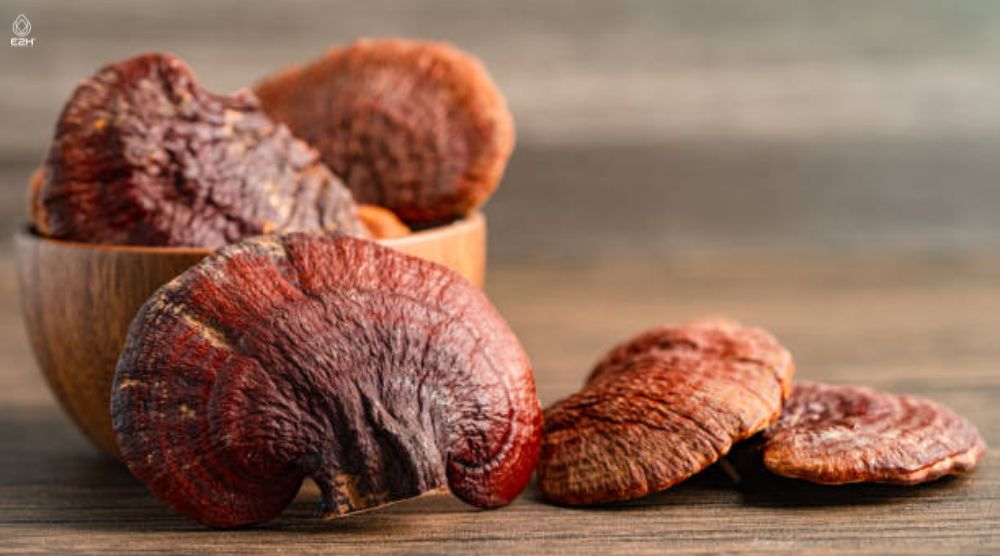
How can the medicinal qualities of Reishi mushrooms be preserved when cooking them in a slow cooker?
To preserve the medicinal qualities of Reishi mushrooms when cooking them in a slow cooker, it’s important to use low heat and a sufficient amount of time. Slow cooking on a low setting allows the mushrooms to release their active compounds without destroying them.
It’s also advisable to add an acid, like a splash of vinegar, which can help to break down the mushrooms and release their beneficial compounds into the broth. Keeping the slow cooker covered ensures that the volatile compounds don’t evaporate, maintaining the reishi mushroom benefits’s medicinal integrity.
FAQs
Can you add Reishi mushrooms directly to a dish?
Simmer Reishi mushrooms in liquid first to soften, then add to your dish.
What’s the best way to extract Reishi mushroom flavors?
Slow cook or steep in hot water to draw out flavors and beneficial properties.
Is it possible to overcook Reishi mushrooms?
Reishi mushrooms are resilient to long cooking times, which is actually beneficial for texture and nutrient extraction.
Can Reishi mushrooms replace other mushrooms in recipes?
Due to their bitterness, use them as a supplement to other mushrooms, not a replacement.
How do you reduce the bitterness of Reishi mushrooms in cooking?
Combine with sweet or strong-flavored ingredients like honey, ginger, or garlic.
Conclusion
Cooking Reishi mushrooms is a journey of discovery in both taste and health. By simmering them into teas and broths or incorporating them into various dishes, you can enjoy their unique flavor and potential wellness benefits. Remember to cook them slowly to soften their texture and to pair them with complementary flavors to balance their natural bitterness. With these tips, you’re well-equipped to include Reishi mushrooms in your culinary routine.
